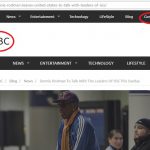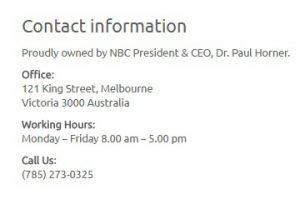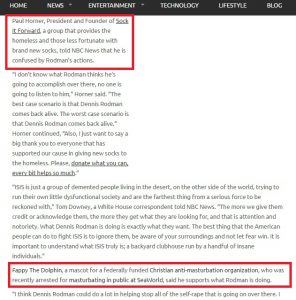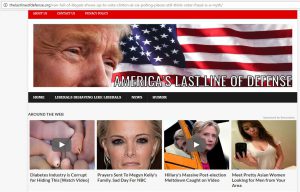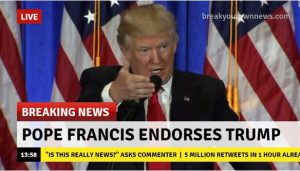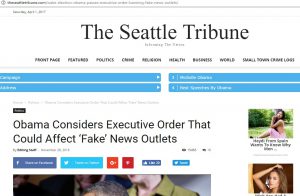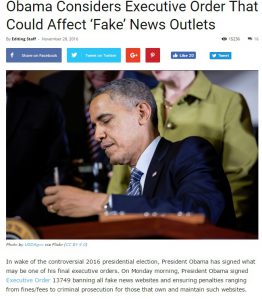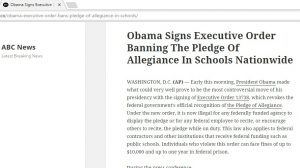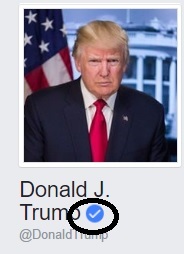Alternative “Facts”or Lies, Misleading Half-Truths, and Just Plain Junk
- They have trouble evaluating information and may not be able to distinguish between advertisements and news articles.
- Students may not be able to identify the source of the information and what the biases may be.
- Students are often unable to distinguish between verified and unverified social media sources.
From: https://goo.gl/W6vJPe (EVALUATING INFORMATION: THE CORNERSTONE OF CIVIC ONLINE REASONING)
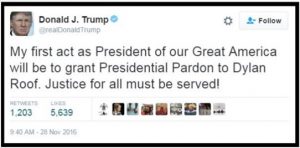 Fake Trump TweetBe aware that even social media images with the blue check indicating that the source has been verified can be faked. Beware of isolated images such as this that aren’t connected to the social media, but only look like a screen shot.
Fake Trump TweetBe aware that even social media images with the blue check indicating that the source has been verified can be faked. Beware of isolated images such as this that aren’t connected to the social media, but only look like a screen shot.- If you base your arguments on false news, it undermines your credibility.
- You might make bad decisions based on false information. Think about bad medical advice and the possible consequences on your health if you follow incorrect information.
- Real news might be beneficial to you. There is a lot of useful information on many topics such as finding student loans, what to do during emergency situations, and information about financial investing.
- It is in your interest to get reliable information about political issues and candidates so you can make informed decisions when you vote.
- Do not share information without verifying its validity.
- Computer scientists at Columbia University and the French National Institute discovered that 59 percent of links shared on social media have never been clicked.*
- Don’t just read the headlines!
From: https://goo.gl/9pkbDq (New Study Highlights Power of Crowd to Transmit News on Twitter)
Examples of Fake News
Always check Contact, Disclaimer links on all the web sites you read. This Contact link leads to supposed contact information about Dr. Paul Horner. If you Google or research his name, you will discover that he has built a series of fake news sites. In the excerpt of the article further down this page, you’ll see that Paul Horner is also listed as the President of Sock it Forward.
Fake news sites rely on the fact that most people do not read the entire article before posting it on their Facebook page or passing it on to friends. However, if you read this entire article, this version even quotes Fappy the Anti-Masturbation Dolphin and his reaction to Rodman’s trip.
Drug lord El Chapo breaks out of prison for the third time
El Chapo is still in prison. Notice the URL ends in com.co. As noted on a previous page, .co is the domain for Columbia. It was also introduced in 2010 as an alternative to .com. Most mainstream, reputable news sources have .com domains because they have been around long before 2010. Does the ABC logo look legitimate?Vans full of illegals show up at six polling places to vote
The creator of this fake news article claiming that vans of illegals were voting repeatedly has the above ads. Reputable mainstream news sources only accept advertisers of products that they are comfortable being associated with. The news sources do not want advertisements on their site that bring into question their reliability or that offend their readers or viewers.Always check the About Us links. You’ll see a Disclaimer below explaining that they make up satirical articles that can all be “baloney”. Most people do not check these disclaimer links and this is what creators of fake news sites count on to spread their news as though their articles were real.
Reputable news sources should be unbiased and avoid using inflammatory language. The news should present facts to inform you, not slurs to appeal to your emotions. Notice that this article calls Hillary Clinton, “Pantsuits McCriminal”.
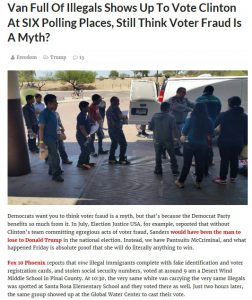
Pope Francis Endorses Donald Trump
The librarian putting together these webpages made this breaking news image in under five minutes using a news generating web site. Don’t trust images disconnected from its supposed source. They can be faked.Identify Bogusness
- The author is anonymous.If an author is unnamed, be suspicious. If the story were true, why wouldn’t the author put his or her name on it? However, anonymous stories may be a sign of bogusness, but not always.
- The author quotes a famous person. Quotes that are attributed to famous people can turn out to be false as well. By using a famous person’s name, the author may be trying to legitimize the fake news by making it appear to be supported by authoritative sources.
- The author loves using exclamation points!!! The author is trying to get an emotional response from you instead of appealing to your logic. The same applies to excessive use of capital letters.
- The fake news refers to a legitimate source that completely contradicts the information in the fake source.Some stories will invite readers to check out the claims, even providing a link to a respected source because they know most people won’t check the links. Verify claims. Warning: Phishing attempts have become more sophisticated, so before you click on a hyperlink in a suspicious email or article, make sure that it is in fact the correct URL and will bring you to the respected source you want. Try Googling for the outside source instead, if in doubt.
- The message is riddled with spelling errors.Why should you trust an author who is semi-illiterate?
- The message argues that it is NOT false.Be skeptical about any message that says, “This is NOT a hoax!”
- There’s math involved.Check it.
From: Factcheck.org at https://goo.gl/nPCUi (That Chain E-mail Your Friend Sent to You Is (Likely) Bogus. Seriously.)
- Be careful of news websites ending in .com.co. .co is the top level domain for Columbia. Also, com.co was introduced in 2010 as an alternative to the overly abundant .coms. However, most mainstream, reputable news sources have .com domains because they have been around long before 2010.
- In general, watch out for odd domain names since they generally signal suspect news sources.
- Bloggers might post articles under legitimate news brands, but they may not go through the same editing process.
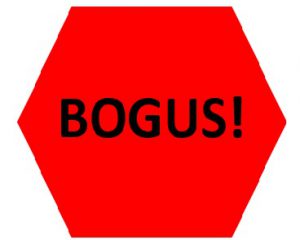
More Antidotes to Alternative Facts: Fact Checking
- First, read the entire story. Many of these fake news sites know that people do not read the entire article. The beginning of the article may sound legitimate, but some of the articles start to get absurd further into the text.
- Check the credentials of the authors and other people responsible for the web site.
- Look for “About Us”, “Contact Us” and “Disclaimer” links to find out information about authors, editors, publishers.
- If the author makes a claim, try to do a search to verify that claim. Try to find the primary sources for the story. Sometimes the article provides links to primary sources knowing that most readers will not check them. You can do a Google search using search techniques such as limiting to site:edu. This will limit your results to .edu web sites that are hosted by an institution of higher learning. If you add filetype:pdf , your results will be .pdf documents.
- Use vetted sources to fact check claims. Scholarly peers in the authors’ same discipline or editors at more popular publications review articles in the subscription databases that instructors encourage students to use. These databases can be accessed at http://library.fullcoll.edu/databases/ Information sources should have been through a review process that increases the likelihood of their reliability.
- Check to see if there are other mainstream sources that are reporting on the same topic. If you do not find other sources reporting on a story that should be making the news, it’s probably false.
- Look for a strong bias in the story. News articles should try to be balanced; they should not be appealing to your emotions with inflammatory language.
- Check the date to see if you have the most up-to-date information.
- Look for the story on some of the fact-checking, de-bunking web sites listed on the Online Resources page.
- The source is The Seattle Tribune. If you Google Seattle Tribune to find out more information about this news source, you’ll discover that it’s a satirical web site.
- There are no links for “About us”. Look for the author. When clicking on the editing staff link, there is no information for the responsible authors. This is usually a sign of an unreliable site if there is no information about authors or editors.
- The Disclaimer link states that the Seattle Tribune is a news and entertainment satire site.
Try to fact check the claim. Did Obama sign an Executive Order on fake news outlets? Verify with primary sources if possible.
- On the surface, the news story may seem legitimate. The text links to outside sources that would appear to verify their claims. However, if you check the primary source (the Federal Register at https://www.federalregister.gov/) and take the extra necessary step of verifying the content of Executive Order 13749, you’ll discover that the executive order is actually entitled, “Providing for the Appointment in the Competitive Service of Certain Employees of the Foreign Service” and has nothing to do with fake news web sites.
Check to see if mainstream news sources reported on the same issue or event.
- Search the library databases that include current newspaper articles. You will find that no reputable newspaper or magazine reported that Obama signed an Executive Order 13749 about banning fake news sites because it never happened.
- Take note of the advertising. Reputable mainstream news sources will not accept advertisements that might be offensive such as ads about women seeking American boyfriends.
Online Resources
Exercises
Answers
-
If you see a blue badge
 on a Page or profile, it means that Facebook confirmed that this is the authentic Page or profile for this public figure, media company or brand. Keep in mind that not all public figures, celebrities and brands on Facebook have blue badges.
on a Page or profile, it means that Facebook confirmed that this is the authentic Page or profile for this public figure, media company or brand. Keep in mind that not all public figures, celebrities and brands on Facebook have blue badges. -
If you see a gray badge
 on a Page, it means that Facebook confirmed that this is an authentic Page for this business or organization.
on a Page, it means that Facebook confirmed that this is an authentic Page for this business or organization.
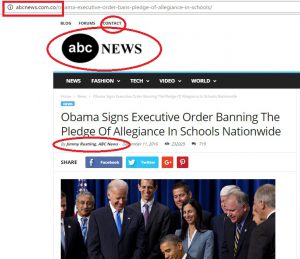
-
- Look at the logo on this website. The ABC logo on this fake site is an oval, NOT the ABC circle, because they want to avoid being accused of misappropriating the real ABC logo.
- Try Googling to find the real ABC News web site. Compare the address that you find with the address on this site. You should see that the domain is different. The real site address is http://abcnews.go.com/
- Look for About, Contact Us, Disclaimer links. Anything to provide you with more information about the people responsible for the web site and its articles. If you click on the Contact Us link, you see the photo below. Does this look like it would be ABC headquarters?

- The author of the article is listed as Jimmy Rustling. You can find “jimmy rustling” in the online Urban Dictionary or you may already know the slang usage. If you click on his name, it takes you to a satirical biography. It starts out, “Born at an early age…” Would you be born at a late age? He also spends 12-15 hours per day supposedly teaching his adopted Syrian refugee daughter how to read and write.
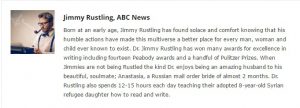
- Try to find primary sources to fact check the claims. If you go to the Federal Register web site at https://www.federalregister.gov/, you can look up Executive Order 13738 and read the actual text of this order to see that it has nothing to do with banning the pledge of allegiance.
- Read the entire article because many fake news stories sound legitimate in the first paragraphs. The author knows most people won’t read the entire article so you may notice many ridiculous sentences such as the one quoting Fappy the Anti-Masturbation Dolphin halfway into the story. The author can then claim that the article is obviously satirical and for entertainment. Paul Horner’s name appears in many fake news stories because he has built a business of fake news sites and this appears to be his little joke. He also denigrates the Snopes.com creator because the Snopes site debunks fake news sites such as his. Despite the many clues that this is a fake news story, you can read the comments below the article by many outraged people who believe that it is true. Don’t be tricked by fake news!

- The breaking news at the top is outdated. This screenshot was taken on April 1, 2017, but the news dates from 2016.
- When a reader tries to click on the About Us or Contact links, they go nowhere.
- This fake news page is very tricky because many of the links lead to the real NBC News site. However, a tip-off is the change in URL from http://www.nbcnews.center to http://www.nbcnews.com which is the real address for NBC News. Notice that the real NBC News site has a different interface design than the fake site. Also, reputable news sources will accept advertisements from mainstream companies such as IBM or Holiday Inn Express, not sex ads that you might sometimes see on fake news sites.
- Reputable news sources will not promote products as part of their story, only as separate paid advertisements or commercials.
- Try to find articles or studies about Intelleral in a subscription database such as EBSCOhost (at http://library.fullcoll.edu/databases/).
- At the bottom of the article, it says, Editors Note: As of Sunday, March 19, 2017, Intelleral is currently IN STOCK. News editors would not be commenting on the availability of a product. This fake news article is one large sales pitch.






